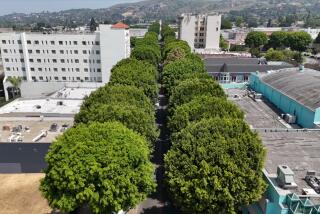Beware: Ficus Failings Are Hard to Root Out
- Share via
Ficus, in my mind, are what one fellow gardener used to call “garden thugs.”
I should quickly point out that I have several specific ficus in mind: Ficus microcarpa (also sold as F. retusa) and the closely related F. m. nitida and F. benjamina. These are by far the most commonly planted of the 800 or so ficus.
These ficus can be handsome container plants, indoors and out, but let them loose in the garden or on sidewalk medians, and be prepared to defend yourself.
Not everyone agrees with me. The “Sunset Western Garden Book” (Sunset Publishing, 1997) says of F. m. nitida that “it is difficult to find a more satisfactory tree or tub plant for warm climates.” I can only imagine that they have never lived with one, at least for very long.
If a ficus happens to be your street tree, as it is for my neighbors on the next block, it may be the only thing you’ll be able to grow in your frontyard--because the tree’s shade is so dense and the roots so aggressive.
If you have a ficus hedge in a sideyard, you’ll constantly be pruning it back, and eventually the trunks will get as fat as the hedge, until there is no longer room for foliage.
If a ficus grows in your neighbors’ backyard, it will shade your yard as well, and the roots will be everywhere in your garden, not to mention theirs. In fact, if you see someone digging up their sewer line, it is probably to rid it of ficus roots.
Ficus may be majestic trees, but they need lots of room, much more than will be found in a sidewalk planting pocket or in a garden, two places where they probably shouldn’t be planted.
*
Many share this view, especially when it comes to the roots.
“The roots from the ficus on the street were sucking the life out of our rose garden,” said Wade Roberts, director of the public Sherman Library and Gardens in Corona del Mar. Distance and a big concrete wall didn’t help.
On the Hollywood Walk of Fame, ficus roots are accused of cracking the sidewalk. Although some are blaming subway construction, I suspect the ficus are at fault.
They are such experts at sidewalk demolition that they have become the skateboarder’s favorite tree. Ficus roots can tilt slabs of sidewalk into formidable and challenging ramps, although the evergreen magnolias on my street do nearly as good a job.
This sidewalk-cracking prompted the removal of the ficus along Pacific Coast Highway in Corona del Mar. In time, all the ficus between Avocado Avenue and Hazel Avenue will be replaced by alternating Hong Kong orchid trees (Bauhinia) and king palms.
A test planting has been installed in two locations, one right in front of Sherman Gardens, “and the difference is spectacular,” Roberts said.
It’s not that Sherman Gardens has it in for ficus. Several other handsome varieties are growing on the grounds, including the rusty leaf fig (F. rubiginosa), the bold fiddle leaf fig, the delicate-appearing Ficus religiosa, the Mexican F. petiolaris and the regular, variegated and miniature forms of F. benjamina.
The Ficus benjamina at the gardens are all in pots, however. Sherman Gardens tried them in the ground, but the plants got too big and the staff had a devil of a time getting the trunks out. “Never again,” Roberts said.
In containers, ficus are the near-perfect plant, with shiny, dark green leaves that gracefully weep. Their only fault is that whenever they are moved, they tend to yellow and then drop leaves.
Ficus will also drop leaves if they get too dry, but if the leaves yellow first, it is probably because of the moving. They’ll recover on their own if you resist giving them extra water or fertilizer.
Their behavior is very different in the ground, where they quickly become dense 30-foot trees that nothing will grow under.
*
So why are ficus so popular as street and garden trees? “On the surface, they have all the desirable qualities,” Roberts said. “They are easy to find, grow fast, have no serious pests, are extremely easy to prune and need little water.”
Although they can be whacked back--into a lollipop shape or even into a hedge--they are, in fact, very expensive to prune properly. A well-pruned tree should be “laced out” or opened to allow light into and through the tree.
“There are some really nicely pruned ficus at the northeast corner of South Coast Plaza” in Costa Mesa, Roberts said, “but if you look at the ground, it’s still all buckled.”
Pruning the trees properly every year costs more than most cities or homeowners can afford.
Impatient store owners sometimes just cut the trees back to stubs to reduce their sign-hiding size and density, but this draconian method is the equivalent of the old medical practice of amputating a limb to save the patient. Trees will recover, but they’ll be denser than ever and more likely to break in the wind.
It would be kinder and wiser to replace them with less aggressive--and maybe more ornamental--street trees.
Ficus microcarpa nitida are not quite pest-free either. They become infested with Cuban laurel thrips that are nearly impossible to control because they roll up the leaves and hide inside. The thrips make very noticeable brown welts on the leaves. Systemic chemicals formerly used to control these thrips are no longer legal, so most cities no longer spray.
The winged thrips not only disfigure the trees, but make dining or even sitting near a ficus distinctly uncomfortable in certain seasons when they fly around the trees.
But I suspect the reason ficus are planted so often is that they are easy and cheap to buy.
When we first moved into our house, the former landlords of the house next door quickly planted a hedge. We like to joke that it was after they spotted our three kids. Ficus were easy to find at the corner nursery, so that’s what the landlords planted. They also knew how fast the plants grew.
Cities are similarly motivated but after about 10 years often regret the decision. They find it impossible to keep up with the ficus when it comes to pruning, and the roots get into sewer lines and lift sidewalks.
I suspect that many homeowners also regret planting ficus after about 10 years--and after about five calls to the rooter service. Homeowners, be forewarned.
In the Garden is published Thursdays. Write to Robert Smaus, SoCal Living, Los Angeles Times, Times Mirror Square, Los Angeles, CA 90053; fax to (213) 237-4712; or e-mail [email protected].






